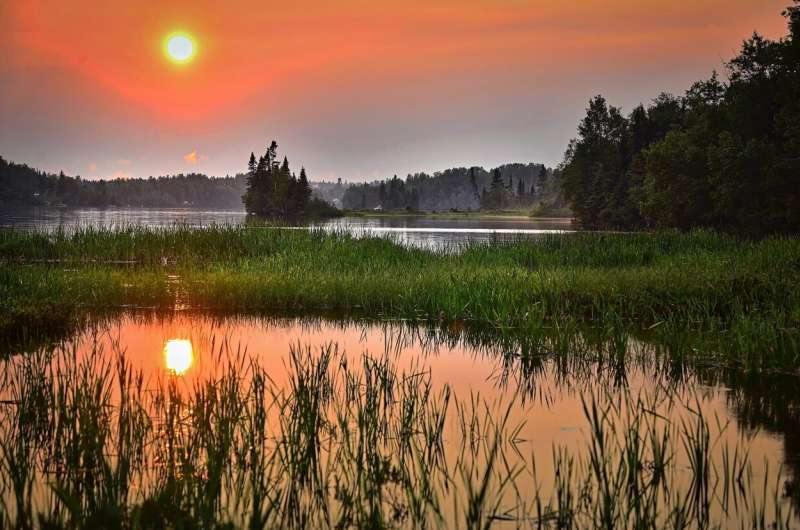Colorado's subalpine wetlands may be producing a toxic form of mercury

Gaby Clark
scientific editor

Alexander Pol
deputy editor

The wetlands found across the Rocky Mountains of Colorado just below tree line are magical places. Dripping with mosses and deep green sedges, these open expanses flanked by evergreens are a breathtaking sight for passing hikers. Moose graze there, and elk gather during their mating season.
These subalpine wetlands are also crucial for from the highlands to metropolitan regions downslope, including Denver.
However, new research shows the wetlands also harbor a health risk. In , my found that just below the surface of subalpine wetland soils, the perfect conditions exist for the production of methylmercury, a potent, toxic form of the heavy metal mercury that can .
As , and , this toxic form of mercury can be produced in the wetlands.
The Goldilocks problem
Methylmercury is a neurotoxin that , meaning it becomes more concentrated as it moves up the food chain. Predatory birds and fish high on the food chain are most susceptible to its devastating effects on the nervous and reproductive systems, as are the .
In the 1950s, hundreds of people in Minamata and Niigata, Japan, died from methylmercury poisoning connected to ingesting water, fish and shellfish from near where .
Mercury methylation is a fickle process. require sources of inorganic mercury and energy, as well as oxygen-free conditions.
Sulfate concentrations are particularly important. Like in "," too much or too little sulfate is unsatisfactory to the methylating microbes—those creating methylmercury. Too little sulfate, and they won't stimulate mercury methylation. Too much sulfate, and mercury gets sequestered in mineral form, minimizing its risk to living organisms.
Yet, when moderate sulfate concentrations mix with inorganic mercury and organic carbon in a low-oxygen environment, the conditions are dangerously "just right," as Goldilocks would say, and methylmercury production is high.
New evidence of methylmercury
Prior to our study, most wetlands found to have methylmercury pollution were in lowland areas, , where the process is . However, our study demonstrates that methylmercury production occurs in seemingly remote mountain locations, too.
There are a few reasons why conditions in Colorado's subalpine wetlands are just right.
First, the soil has ample organic matter, providing a deep store of energy in the form of carbon to fuel methylation. In Colorado's subalpine wetlands, that saturates with snowmelt flowing from the highest peaks.
Second, mercury pollution from industrial centers reaches the Rocky Mountains. Most of the mercury that enters subalpine wetlands has actually traveled all the way from . Eventually, it falls out of the atmosphere in rain or dust, and .
Third—and this is the key stimulating effect for methylating bacteria—subalpine wetlands receive excess sulfate from warming alpine areas in elevations above them. As rising air temperatures drive the , more sulfate than was already in the ground flows into streams to the subalpine region.
The result is that these ingredients mix in the flooded, often oxygen-free environment of the wetland soils, and bacteria have everything they need to produce methylmercury.
Our study showed that the concentrations of methylmercury are higher at the outlet than the inlet of subalpine wetlands that we studied in the Colorado Rockies, providing that wetlands can be a source of the contaminant.
Apart from the local effects of methylmercury on wildlife, our discovery highlights a concern for water supplies. Over 3 million people in the Boulder-Denver metropolitan area rely on clean, fresh water from the mountains. Contamination of the source area by methylmercury may have large-scale ramifications, such as costly treatment measures, for the entire Colorado Front Range's drinking water supply.
How to lower the risk
are experiencing many effects that can feed the production of methylmercury.
In , there is at least one mercury toxicity warning for surface waters, typically urging people not to eat fish or shellfish caught there or to limit the amount they eat. Greater production of methylmercury, and its threat to food and water sources, is now a part of our changing world.
So, what can be done to avoid the risk?
Lowering mercury deposition requires curbing industrial emissions. In 2013, over 140 nations, including the U.S., signed the , committing to regulate and monitor industrial mercury sources. Remaining committed to this agreement is critical.
Reducing the flow of sulfate from ice and rock weathering in the mountains—another key ingredient to this process—requires addressing climate change.
People, governments and industries can take many steps to slow the rise of air temperatures that are increasing ice thaw, from not driving gas-powered vehicles as much to regulating carbon dioxide emissions from power plants and factories. Our new research on methylmercury shows another reason why taking steps to slow climate change are worth the effort.
More information: Hannah R Miller et al, Climate-driven sulfate export in alpine watersheds may stimulate methylmercury production, Environmental Research Letters (2025).
Journal information: Environmental Research Letters
Provided by The Conversation
This article is republished from under a Creative Commons license. Read the .![]()



















